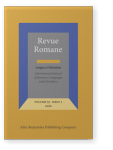Vol. 57:1 (2022) ► pp.55–85
Sí and hoc in the history of Catalan
From the 13th to the 17th century
Old Catalan presents two affirmative particles competing for the same function between the 13th and the 17th centuries: sí and hoc. This article explores their syntax and the factors that contributed to the rise of the former and the disappearance of the latter and accounts for their distribution in the written record. Traditionally, it was believed that hoc was the only positive sentential proform active in the language until the 15th century. However, sí had already been grammaticalised as such by the 13th century, its new function being obscured in the written record by the pervasive use of the official koine established by the Crown of Aragon’s Cancelleria in learned prose. Nevertheless, in documents closer to speech, sí makes a much earlier appearance and shows great vitality before the 15th century, the last century when hoc was still hegemonic before finally disappearing as a consequence of external and internal factors.
Article outline
- 1.Introduction
- 2.The data
- 3. Sí and hoc in the written record: A description of the sub-corpus
- 4.
Sí, hoc and their syntax
- 4.1 Sí and its syntax
- 4.2 Hoc and its syntax
- 5.An analysis: The rise of sí and the fall of hoc
- 5.1Cultural and historical context
- 5.2The rise of sí and the fall of hoc
- 6.Summary of findings
- Notes
-
References
